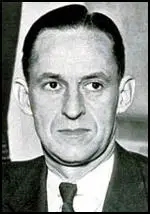Marriner Eccles

Marriner Stoddard Eccles, the son of the banker, David Eccles, was born in Logan, Utah, on 9th September, 1890. He attended Brigham Young College before serving as a Latter-day Saint mission to Scotland. After his mission he worked in the family business in Blacksmith Fork Canyon.
On the death of his father he took over the leadership of the Eccles-Browning Affiliated Banks. Eccles was a supporter of President Franklin D. Roosevelt and his New Deal. He was also an advocate of the economic ideas of John Maynard Keynes and Lauchlin Currie worked at the Treasury Department under the treasury secretary Henry Morgenthau.
Eccles went before the Senate Finance Committee in 1933. According to Patrick Renshaw, the author of Franklin D. Roosevelt (2004): "Though the young Mormon banker from Utah claimed never to have read Keynes he had nevertheless jolted Senate finance committee hearings in 1933 by urging that the federal government forget about trying to balance budgets during the depression and instead spend heavily on relief, public works, the domestic allotment plan and refinancing farm mortgages, while cancelling what remained of war debt."
Roosevelt was not totally convinced by Eccles' economic theories but in November, 1934, he appointed him as Governor of the Federal Reserve Board. As William E. Leuchtenburg, the author of Franklin D. Roosevelt and the New Deal (1963), has pointed out: "Eccles had hardly taken office when he helped draft a new banking bill which called for the first radical revision of the Federal Reserve System since its adoption in 1913. Eccles wished to lodge control of the system in the White House; lessen the influence of private bankers, who he believed had taken over the system; and use the Reserve Board as an agency for conscious control of the monetary mechanism."
In 1935 Eccles and Currie drafted a new banking bill to secure radical reform of the central bank for the first time since the formation of the Federal Reserve Board in 1913. It emphasized budget deficits as a way out of the Great Depression and it was fiercely resisted by bankers and the conservatives in the Senate. The banker, James P. Warburg commented that the bill was: "Curried Keynes... a large, half-cooked lump of J. Maynard Keynes... liberally seasoned with a sauce prepared by professor Lauchlin Currie." With strong support from California bankers eager to undermine New York City domination of national banking, the 1935 Banking Act was passed by Congress.
In February 1944, President Franklin D. Roosevelt appointed Eccles for another 14-year term on the Federal Reserve Board. However, he did not enjoy such a good relationship with President Harry Truman and in 1951 he resigned from his post. After his retirement he wrote his memoirs, Beckoning Frontiers (1952).
Marriner Stoddard Eccles died in Salt Lake City, Utah, on 18th December, 1977.
Primary Sources
(1) William E. Leuchtenburg, Franklin D. Roosevelt and the New Deal (1963)
Eccles had hardly taken office when he helped draft a new banking bill which called for the first radical revision of the Federal Reserve System since its adoption in 1913. Eccles wished to lodge control of the system in the White House; lessen the influence of private bankers, who he believed had taken over the system; and use the Reserve Board as an agency for conscious control of the monetary mechanism. The 20,000-word banking bill introduced in February, 1935, reflected the thinking of Eccles and of certain members of his staff, especially the Keynesian Lauchlin Currie.
